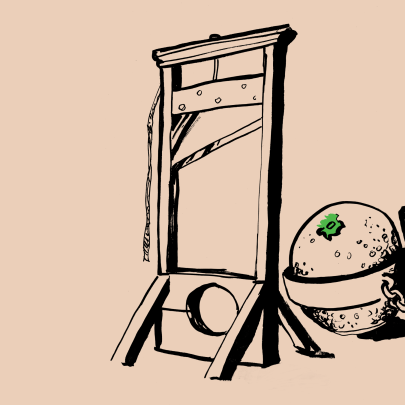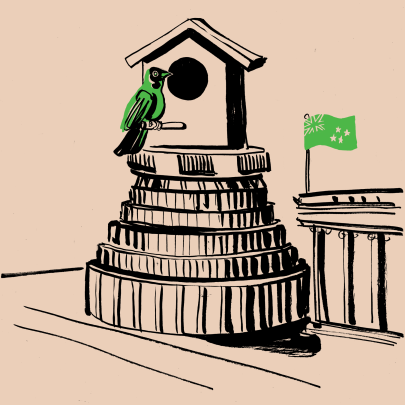Jul 24, 2015 Politics
How about that Mike Hosking, eh? He’s so important, topping the ratings for breakfast radio and prime-time TV, he gets parodied twice over: by Jeremy Wells in his brilliant “Like Mike” Hosking Rant on Hauraki, and by @MikePerfectHosk on Twitter. Who else gets that much attention?
But don’t forget Hosking’s erstwhile competitor on TV3, John Campbell. He’s gone now, but not before revealing an enormous level of influence (until his departure was announced, we had him in our top 10). During the six weeks of crisis while his bosses pondered his show’s future, and despite getting no marketing support from the network at all, Campbell topped the ratings for all TV3 shows 16 times.
Yes, Hosking gets bigger numbers and is influential for that (and let’s not forget the value of Toni Street in keeping his show even vestigially credible), but it was Campbell — crusading in exactly the way a good magazine current affairs show should — who changed the conversation and got things done. TV3 should have been so proud of that.
But MediaWorks board member Julie Christie was always going to have the last word. Although in this country boards don’t usually control editorial activity, Christie doesn’t care about that, and besides, she also has an executive role, charged with making the broadcaster more “entertainment focused”. Dominic Bowden is her star: the essential rock of trust and likeability on which her new reality TV empire is being constructed. He’s bloody good at it, too.
The only trouble is — have her board colleagues noticed? — the ratings for X Factor and her other reality shows have been weaker than Campbell’s, especially given the targets they are meant to hit. Christie is in charge, but her rule will not be golden.
Nor is she the most influential executive in Auckland media. That distinction belongs to Jane Hastings, CEO at NZME. (formerly APN).
NZME. has a silly full stop at the end of its name, but among large media companies it has the clearest commitment to “digital first”, and the fastest-growing integration of online, print, on air and event platforms, not to mention a seriously influential hook-up with TVNZ. Hastings, heading up a largely new and largely female executive team, is changing the media experience for consumers and advertisers alike.
The Herald is still the Herald, though, and supposedly still our newspaper of record. It has a tabloid front page and quite a bit of tabloid content, but its canny editor Shayne Currie runs a much more complex — and in many ways impressive — operation than that. He has some of the country’s best investigative journalists, especially David Fisher, Matt Nippert and Jared Savage, and a highly respected press gallery crew headed by Audrey Young and John Armstrong.
Under the stewardship of Amanda Linnell, the Viva section makes a bold showing in fashion and food every Wednesday. Bernard Orsman (along with Todd Niall at Radio New Zealand) is the city’s most influential town hall reporter. Chris Rattue is a must-read sports columnist, Brian Rudman is just as important in civic affairs and Fran O’Sullivan is supremely well-informed and insightful about the intersection of politics and business (Rod Oram at the Sunday Star-Times is her perfect foil).
Mind you, the most formidably influential writer at the Herald is none of the above. It’s gossipmonger Rachel Glucina, who seems hell-bent, with Currie’s collusion, on trashing her paper’s good name (see over the page for more on that).
Currie is immensely powerful — what politician or business leader would not take his call? — but he’s just been bumped upstairs. As the new managing editor across all Herald activity his influence will be spread more widely but felt less keenly. At our press time his successor had not yet been announced.
Elsewhere, at Metro publisher Bauer Media, the enthusiastic Sido Kitchin runs the two leading mass-market titles (Woman’s Day and NZ Woman’s Weekly), putting her in touch every week with a third of New Zealand women.
In radioland, Hosking aside, Fletch, Vaughan and Megan (recently pinched by ZM from The Edge) resonate powerfully with many listeners, while Guyon Espiner has restored some credibility to RNZ’s Morning Report. But the most engaging radio personality is The Hits host Stacey Morrison, who also turns out for Maori TV and TVNZ. She is a political commentator, te reo advocate and educator, and is, we are told, so committed to never wearing flats, she has been seen efficiently navigating her way across rocks in spiky heels while holding a baby. Superwoman.
Auckland blogs? In politics, the best way to keep up is to read Russell Brown (Public Address), Cameron Slater (Whaleoil) and Martyn Bradbury (The Daily Blog). Whatever your views, you’ll have to hold your nose for at least some of it: Brown is the epitome of reason, but neither Slater nor Bradbury ever let a considered view get in the way of a rant.
Actually, if we’re talking about influence and not just making a noise in an echo chamber, the political blog with the biggest clout could just be Auckland TransportBlog: 90,000 visits a month isn’t bad for policy wonkerism.
The company that makes most of the good and middling and sometimes bad drama and comedy we see on TV is South Pacific Pictures (Shortland St, Outrageous Fortune, Nothing Trivial). Founder John Barnett has been extremely influential for decades, but he’s semi-retired now and his mantle is shouldered by the dynamic Kelly Martin.
SPP works with a talented but very narrow creative pool: Rachel Lang, James Griffin, Gavin Strawhan, Fiona Samuel and Kate McDermott. If someone blew up the Gypsy Tea Room almost our entire television writing population would be wiped out.
Kathleen Anderson is the programmer who decides what gets made, and how, for TVNZ. Lisa Taouma and her team have enormous influence among Pasifika communities with their TV series Fresh and website The Coconet. Fresh catchphrases like “I got the swakk” are rife among high-school kids (and adults) across parts of Auckland. The Coconet has entertaining “how to” videos that help New Zealand-born Pacific Islanders learn cultural traditions like how to siva Samoa, cook green bananas and give gifts.
Ant Timpson runs the 48 Hour film competition, the annual opportunity for hundreds of creative and very determined filmmakers, young and not-so-young, to strut their stuff. Lightbox CEO Kym Niblock is doing an impressively good job in taking on the entertainment juggernaut Netflix.
And, for better and for worse, where would we be without PR? The city’s reigning event impresario, campaign strategist, media manipulator, profile puffer and crisis manager is Deborah Pead. Curiously, she’s widely respected and near-universally liked.
As for influential new media shit, you can’t go past the #bringdowntheking Game of Thrones promos (with a statue of King Joffrey in Aotea Square) created for DDB by digital creative Haydn Kerr.
The Top 10 Most Influential in Media
1. Jane Hastings
2. Mike Hosking
3. Julie Christie
4. Shayne Currie
5. Rachel Glucina
6. Sido Kitchin
7. Kelly Martin
8. Deborah Pead
9. Stacey Morrison
10. Bernard Orsman
Not so influential really
Paul Henry: Who? Despite the biggest ad campaign we’ve ever seen (well, it feels like that), no one is watching. His TV audience is under 50,000. Paul Henry is the new Phillip Sherry.
Mark Weldon: It’s The Julie Christie Hour at MediaWorks, never mind that Weldon is CEO and a friend of the PM. So is she. Weldon’s a media lightweight; Christie has a lifetime of successful, intensely competitive experience.
Everyone except Mike Hosking at TVNZ: What’s the point of state broadcasting again? If they can’t give us quality, couldn’t they at least try to be entertaining?
Everyone at Fairfax: The Sunday Star-Times is the flagship in Auckland, and what have they done? Failed to launch a long-awaited digital newspaper off the back of it; got rid of almost all the commentators worth reading (which breaks pretty much the only rule in media you can still rely on). Fairfax looks exactly like a company run by a bunch of possums stuck in the headlights.
John Fellet: Even five years ago, the boss of Sky TV would easily have topped our Media Influentials list. Too much competition for that, now, and despite still having all the sport worth watching and quite a bit of quality drama too, Sky doesn’t seem to know where to look. Is this our Nokia?





